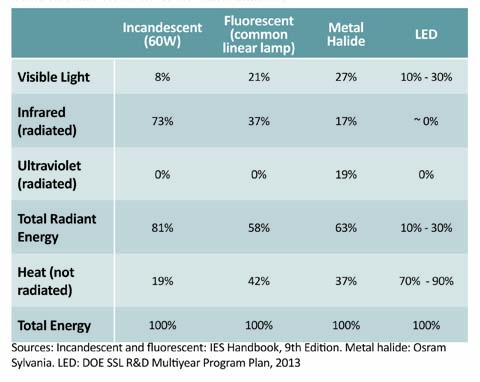How To Address Common LED Myths During Planning
As the cautions noted above indicate, benefits aren't the only things to keep in mind when evaluating the use of LEDs in building applications. That's why the list of factors to consider goes on to include myths or half-truths about LEDs, and how to address them in your planning.
7. "LEDs produce no heat." Actually, LEDs do produce heat, but they prefer to keep it to themselves. All lighting technologies have some inefficiency that results in wasted energy. That energy is either radiated as ultraviolet or infrared waves along with the visible light, or is not radiated, remaining with the light source itself as heat. Management of this heat through heat sinks or other means is a key element of LED lighting design, because this excessive heat can significantly impact the performance of the LED components. The box on page 40 ("Energy Waste in Common Light Sources") shows a basic comparison of common lighting technologies and where the energy goes; it highlights the higher heat issue with LED technologies.
LEDs do not emit infrared radiation, so heat generated inside LED products must be thermally conducted away from the LEDs to avoid accelerated lumen depreciation, color shift, or catastrophic failure of electronic components.
8. "LEDs are more efficient than any other light source." They certainly can be, but LED product quality and efficiency still varies widely. The majority of available LED luminaires and replacement lamps provide useful efficacies beyond incandescent and most fluorescent products, but some are still lagging. The takeaway: Be aware that not all LED products are considered equal in terms of light output and efficacy.
9. "LEDs last 100,000 hours to forever." Fortunately, this rhetoric has toned down in recent years, but lifetime claims are still a concern. The key point is that all light sources degrade with time, including LEDs. Most stop working due to filament or cathode failure (catastrophic) before a critical light output level is reached. LEDs, having no filament or cathode, will potentially continue to operate for a very long time. However, their light output will diminish over time, eventually reaching unacceptable levels; their emitted color may shift; or the complete product may fail due to driver or other component failure.
The lighting industry considers useful lumen output level as one measure of the useful life of an LED. This is often expressed as a point where 70 percent of the initial light output remains. However, there is considerable movement in the industry to look at other methods of judging effective LED life, in part because, as noted above, lumen degradation is only one part of a product's life. Keep in mind that LED products include many components other than the LED chip; these components can also fail. The huge range of drivers and other electrical components, and the infinite variety of LED product design approaches, make it difficult to generalize about LED product reliability and lifetime. Until time produces more information, the key is to identify a product associated with quality manufacturing history or test data that can provide confidence in its reliability.
For now, the Illuminating Engineering Society (IES) has provided two standard test methods to make sense of the lumen degradation issue. One, called LM-80, defines how to measure LED lumen depreciation for a minimum of 6,000 hours. The other, TM-21, provides a mathematical way of extrapolating this decay for much longer periods of time. You will likely see manufacturer's information that quotes TM-21 values. Note that the current TM-21 document provides for calculation of an extrapolated potential lumen decay value but then restricts claims to a more conservative reported value. This is done because the mathematical statistics of extrapolation provide limited confidence in large life claims that go far beyond the limited test data. The cautious suggestion would be that when you see a "calculated" TM-21 value, ask for the "reported" value and then you will have a good set of numbers to compare between products.
10. "LEDs are easily dimmable." The nature of the basic LED technology is to be easily dimmable compared to fluorescent and high intensity discharge (HID) technologies. However, that does not mean that all LED products will be perfectly dimmable on all dimming systems. The dimmer control must be matched with the LED and driver system for effective dimming capability. Diligence is needed: You have to ask manufacturers to identify which dimmer technology and driver electronics will be compatible and provide effective control.
Energy Waste in Common Light Sources
With LEDs, most wasted energy is in the form of heat.
(All percentages refer to "white" light sources.)

Related Topics:
















